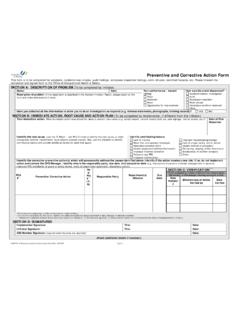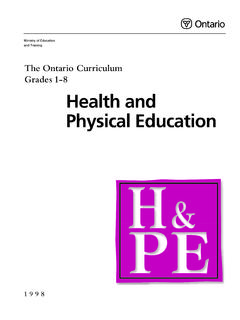Transcription of The Ontario Curriculum Social Studies - University …
1 The Ontario CurriculumSocial StudiesGrades 1 to 6 History and GeographyGrades 7 and 8 Ministry of Education2004 REVISEDC ontentsIntroduction ..2 The Importance of Social Studies , History, and Geography ..2 Social Studies ..2 History ..2 Geography ..3 The Goals of Social Studies , History, and Geography Education ..3 Concepts Underlying the Social Studies , History, and Geography Curriculum ..3 Roles and Responsibilities in Social Studies , History, and Geography Education ..5 The Program in Social Studies , History, and Geography ..7 Curriculum Expectations ..7 Subject Areas and Strands in the Curriculum ..8 Assessment and Evaluation of Student Achievement ..9 Basic Considerations ..9 The Achievement Chart for Social Studies , History, and Geography .. 10 Some Considerations for Program Planning in Social Studies , History,and Geography .. 14 Teaching Approaches .. 14 Cross-Curricular and Integrated Learning .. 14 Study of Current Events .. 15 Planning Social Studies , History, and Geography Programs for Exceptional Students.
2 15 English As a Second Language and English Literacy Development (ESL/ELD) .. 16 Antidiscrimination Education in Social Studies , History, and Geography .. 17 Literacy, Numeracy, and Inquiry/Research Skills .. 17 The Role of Technology in Social Studies , History, and Geography .. 18 Guidance and Social Studies , History, and Geography .. 18 Health and Safety in Social Studies , History, and Geography .. 18 Part 1: Social Studies , Grades 1 to 6 .. 19 Heritage and Citizenship .. 20 Canada and World Connections .. 34 Part 2: History and Geography, Grades 7 and 8 .. 51 History .. 52 Geography .. 65 Glossary .. 78 Une publication quivalente est disponible en fran ais sous le titre suivant : Le Curriculum de l Ontario tudes sociales, de la 1re la 6eann e Histoire et g ographie, 7eet 8eann e, publication is available on the Ministry of Education s website Ontario Curriculum : Social Studies , Grades 1 to 6; History and Geography, Grades 7 and 8,2004replaces The Ontario Curriculum : Social Studies , Grades 1 to 6; History and Geography,Grades 7 and 8, 1998.
3 Beginning in September 2005, all Social Studies , history, and geographyprograms for Grades 1 to 8 will be based on the expectations outlined in this Importance of Social Studies , History, and GeographyStudents graduating from Ontario schools require the knowledge and skills gained from socialstudies and the study of history and geography in order to function as informed citizens in aculturally diverse and interdependent world and to participate and compete in a global econ-omy. They also need to develop attitudes that will motivate them to use their knowledge andskills in a responsible Ontario Curriculum : Social Studies , Grades 1 to 6; History andGeography, Grades 7 and 8, 2004outlines the knowledge and skills that students must developin Grades 1 to 8, as well as the levels of achievement at which they are expected to master focus of teaching and learning in the Social Studies , history, and geography Curriculum ison the development of essential knowledge and skills. Students must develop a thoroughknowledge of basic concepts that they can apply in a wide range of situations.
4 They must alsodevelop the broad-based skills that are vital to success in the world of work: they must learn toevaluate different points of view and examine information critically to solve problems andmake decisions on a variety of StudiesSocial Studies seeks to examine and understand communities, from the local to the global,their various heritages, physical systems, and the nature of citizenship within them. Studentsacquire a knowledge of key Social Studies concepts, including change, culture, environment,power, and the dynamics of the marketplace. They learn about Canada and the role of citizensin a democratic society within a culturally diverse and interdependent world. They alsoacquire skills of inquiry and communication through field Studies and other research projects;through the use of maps, globes, and models; and through the consideration of various formsof historical evidence. Students apply these skills to develop an understanding of Canadianidentity and democratic values, to evaluate different points of view, and to examine informationcritically in order to solve problems and make decisions on issues that are relevant to their involves the examination of individuals and unique events, as well as of groups, move-ments, institutions, nations, and eras.
5 The Grade 7 and 8 history program focuses on Canadaand provides students with a comprehensive overview of the development of their country andits role in the world. Students learn how lessons from the past can be used to make wise deci-sions for the present and the future. As well, by exploring various points of view and evaluatinga variety of historical evidence, they practise achieving a balanced perspective. In these ways,3 INTRODUCTIONthe study of history helps prepare students to be contributing and responsible citizens in acomplex society characterized by rapid technological, economic, political, and Social study of history in Grades 7 and 8 builds on the skills, attitudes, and knowledge developedin Social Studies in Grades 1 to is the study of place. It examines the earth s physical systems and the people in also investigates how people and environments affect each other. In the study of geography,students learn to gather, organize, analyse, and present information obtained from fieldwork,models, simulations, aerial photographs, satellite imaging, maps, and computers.
6 The Grade 7geography program introduces a conceptual framework built around five themes:location/place,environment,region ,interaction, and movement. Teachers will use these themes to organize theirinstructional planning, and students will apply them to develop a geographic perspective totheir Studies . By integrating various aspects of place, the study of geography provides studentswith a unique opportunity to learn about the world around Goals of Social Studies , History, and Geography EducationA basic goal of the Social Studies , history, and geography program is to provide students withthe foundational knowledge, skills, and attitudes they will need to continue to learn effectivelyin secondary school. Thus, the goals of the Curriculum are to enable students to: understand the basic concepts of Social Studies , history, and geography; develop the skills, strategies, and habits of mind required for effective inquiry and communi-cation, and for the application of the basic concepts of Social Studies , history, and geographyto a variety of learning tasks; relate and apply the knowledge acquired through Social Studies and the study of history andgeography to the world outside the goals are equally important.
7 They can be achieved simultaneously in a concrete, practi-cal context through learning activities that combine the acquisition of knowledge with theapplication of various skills, including inquiry/research, communication, and map, globe, andgraphic representation Underlying the Social Studies , History, and Geography CurriculumThe Curriculum in Social Studies , Grades 1 to 6, and in history and geography, Grades 7 and 8,organizes students learning around a set of fundamental concepts:systems and structures;interac-tions and interdependence;environment;change and continuity;culture; andpower and and geography offer different perspectives on these concepts. In history, for example,students may consider change and continuityover a relatively short period that covers only a fewyears in the story of a country or person. In geography, on the other hand, they may use thissame concept to study much longer time periods covering the slow, almost imperceptible,changes in some physical the specific content of programs changes from grade to grade, the conceptual frame-work within which topics are presented remains consistent throughout the Curriculum , fromGrades 1 to 12, and gives continuity to students learning.
8 As students progress through thecurriculum, they extend and deepen their understanding of these concepts and learn to applythis understanding with increasing relationships among concepts is also an important part of student of the fundamental concepts can be linked with a number of related concepts that helpto explain the concept conceptsRelated conceptsSystems and Structures:The ways humans and nature areorganized. Humans have created systems and structures toallow societies to function; natural systems and structureshave developed in response to a variety of natural and Interdependence:The influences shapingrelationships within and among human and natural systems and structures. Human and natural processes and components connect with, adapt to, and have animpact on one :The natural and built elements of which theearth is composed, and the complex web they and Continuity:The fundamental criteria forassessing the development of human and natural systemsand structures.
9 Change is manifested by differences overtime, and is recognized by comparing phenomena andcontexts as they exist at different times. Continuity repre-sents consistency and connectedness over time, and is recognized by exploring the forces within nature andhuman societies that create stability and link the past with the :Expressions of humanity learned and sharedwithin a specified population, influenced by the physicalenvironment. Culture provides a conceptual framework for interpreting the world, and influences the perceptionof time, place, identity, significance, and and Governance:The means and supporting structures whereby laws and rules are enforced in a society and in the global Ontario Curriculum : Social Studies , GRADES 1 TO 6; HISTORY AND GEOGRAPHY, GRADES 7 AND 8 human patterns community cooperation governance causation/cause andeffect natural patterns environment causation/cause andeffect human and natural patterns trade/exchanges globalization human and natural systems human and natural patterns exploitation and utilization of resources causation/cause andeffect human and natural systems human and natural patterns spirituality/religion ideology economic, political,and legal systems communication andlanguage community relationships civic rights and responsibilities environment ecology regions ecosystems urbanization time sustainability tradition conflict and cooperation familial and communitystructures education migration diversity democracy justice security rights and responsibilities conflict and cooperation power relations5 INTRODUCTIONR oles and Responsibilities in Social Studies , History.
10 And Geography EducationStudentsStudents have many responsibilities with regard to their learning, and these increase as theyadvance through elementary and secondary school. Students who are willing to make theeffort required and who are able to apply themselves will soon discover that there is a directrelationship between this effort and their achievement, and will therefore be more motivatedto work. There will be some students, however, who will find it more difficult to take respon-sibility for their learning because of special challenges they face. For these students, the atten-tion, patience, and encouragement of teachers can be extremely important factors for , taking responsibility for their own progress and learning is an important part ofeducation for all students, regardless of their mastery of concepts and skills in Social Studies , history, and geography requires asincere commitment to work, study, and the development of cooperative skills. Furthermore,students must actively pursue opportunities outside the classroom to extend and enrich theirunderstanding of these subjects.
![Palladium-Catalyzed C[bond]N and C[bond]O …](/cache/preview/4/3/9/c/6/e/9/3/thumb-439c6e93d844ff459e84bd8810193673.jpg)












